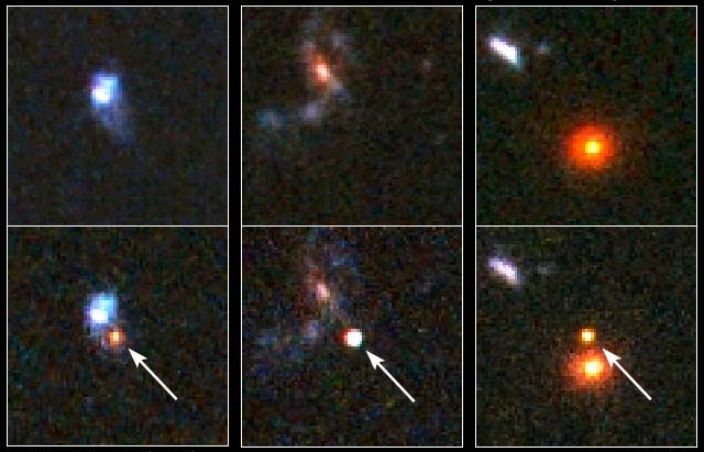Explanation: Only a few short years ago, when the APOD editors were in graduate school, the pervasive, cosmic Dark Energy was not even seriously discussed. Of course, it now appears that this strange energy dominates the cosmos (as well as lectures on cosmology) and provides a repulsive force accelerating the large scale expansion of the Universe. In fact, recent brightness measurements of distant and therefore ancient, stellar explosions or supernovae indicate that the universal expansion began to speed up in earnest four to six billion years ago, when the Dark Energy's repulse force began to overcome the attractive force of gravity over cosmic distances. The Hubble Space telescope images above show a sample of the distant supernova explosions, billions of light-years away, in before (top) and after (bottom) images of their faint host galaxies. Hubble measured supernovae also hint that the Dark Energy's repulsive force is constant over cosmic time and so could be consistent with Einstein's original theory of gravitation. If the force actually changes with time, the Universe could still end in a Big Crunch or a Big Rip ... but not for an estimated 30 billion years.
1999 2000 2001 2002 2003 2004 2005 2006 2007 2008 2009 2010 2011 2012 2013 2014 2015 2016 2017 2018 2019 2020 2021 2022 2023 2024 2025 |
Yanvar' Fevral' Mart Aprel' Mai Iyun' Iyul' Avgust Sentyabr' Oktyabr' Noyabr' Dekabr' |
NASA Web Site Statements, Warnings, and Disclaimers
NASA Official: Jay Norris. Specific rights apply.
A service of: LHEA at NASA / GSFC
& Michigan Tech. U.
|
Publikacii s klyuchevymi slovami:
supernova - cosmology - dark energy - Sverhnovye - Kosmologiya - temnaya energiya
Publikacii so slovami: supernova - cosmology - dark energy - Sverhnovye - Kosmologiya - temnaya energiya | |
Sm. takzhe:
Vse publikacii na tu zhe temu >> | |
